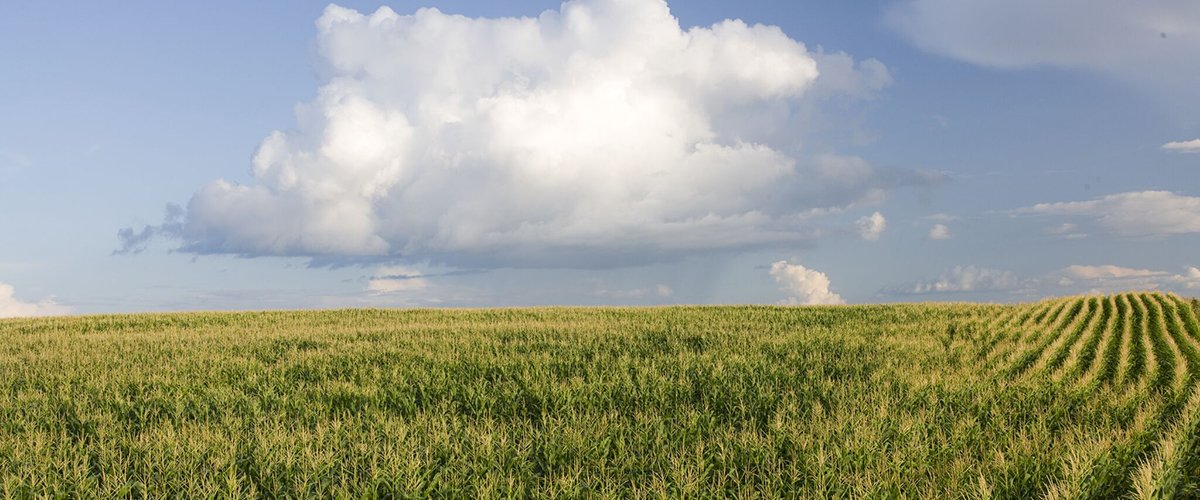
Why you should care about ag R&D
A conversation with the University of Minnesota's Philip Pardey, PhD

When the average person hears the words “research and development,” a farm field might not be the first image that pops into their head. But if you ask Philip Pardey, it should be.

Pardey is a global expert in the bio-economics of technical change in agriculture, sustainable agricultural productivity growth, and the economic impacts of R&D. He is an applied economist and co-director of GEMS Informatics at the University of Minnesota, a joint venture between the College of Food, Agricultural, and Natural Resource Sciences (CFANS) and Research Computing (including the Minnesota Supercomputing Institute and USpatial), and was founding director of the InSTePP (International Science and Technology Practice and Policy) Center. Prior to joining the U of M in 2002, he spent almost two decades working for the international agricultural research system CGIAR.
For National Agriculture Week, we asked Pardey to share his thoughts on why investing research and development dollars in the agricultural sector is so critically important right now — and why the typical citizen should care.
What does ag R&D involve?
Ag R&D (agricultural research and development) covers an expanse of scientific activities directed at using innovations that make agricultural practices, technologies, and food, feed, and renewable fuel systems more efficient, effective, and environmentally sustainable. Soils, plants, animals, and people all play a vital role. Key activities include improving crops; enhancing livestock performance; managing soil and water; controlling diseases and pests; and improving post-farm production systems, all with an eye toward enhancing the lives of people and animals while protecting and preserving our planet.
Why should both the public and private sectors make investing in ag R&D a priority?
Quite simply, because our lives depend on it. Farmers need access to new technologies, new practices, and new varieties of resilient crops and livestock breeds to keep their farms profitable and produce a stable food supply for a global population that keeps growing. So farm livelihoods and food security are right there at the top of the list. Environmental sustainability is also a driving factor. Soil, sunshine, water, and other natural inputs are intrinsic to agriculture. But all these natural resources are under increasing threat. It is imperative that we find new ways to continue improving farm productivity, reduce greenhouse gas emissions, use less pesticides, conserve and protect our water and soil, and much more. This kind of research is essential for a healthy future; we cannot do without it.
Do you think the average person realizes how important ag R&D is?
No, I don't think they do, especially in a country like the U.S. where food is abundant for much of the population. Consumers today are much more aware of where their food comes from, and many are concerned about how what they eat impacts both their own health and the planet's health. While human health research gets lots of public and political attention, I'm not convinced there is widespread appreciation of the science, technology, and innovation that has to happen to produce healthier, more climate-friendly food. It is science and research that brings better products to life — from the seed in the soil all the way to the store shelf. There is so much that happens in that supply chain in between, and ag R&D is critical to continuously improving it.
What are your biggest concerns regarding ag R&D today?
Just when we should be doubling down on ag R&D, the reality is that public investment in ag R&D has dropped by more than one-third over the past two decades in the U.S. After adjusting for inflation, investments by federal and state governments in ag R&D undertaken by land-grant universities such as the University of Minnesota has declined to 1976 levels. USDA research funding has shrunk to levels last seen in 2013, and U.S. private sector food and ag R&D spending has declined of late. Funding for the international ag R&D agencies (the CGIAR) that helped spur a global Green Revolution in agriculture has also dropped markedly. I'm very concerned about these cutbacks in local and global funding, both public and private, to conduct the kind of life-sustaining research that is needed.
In 2021, I co-authored a report titled "Rekindling the Slow Magic of Agricultural R&D" that appeared in Issues in Science and Technology, a policy journal published by the U.S. National Academies of Sciences, Engineering, and Medicine. In it, we argued that right now is exactly the wrong time to decrease public investments in ag R&D. I believe nations should be increasing agricultural research investments, not just to sustain progress already made in the face of climate change and ever-tighter land and water supplies, but also to continue to shrink the number of people living at the lowest levels of poverty and to increase resilience to major disruptions to global food supplies.
What can people do to address this important issue?
I'd encourage people to make their voices heard. They can advocate for increased government funding for ag R&D by contacting their elected officials, participate in public dialogues, and support policies that make ag and food innovation a priority. They also can support agricultural research organizations, such as universities and non-profits, with funds or resources. I'd also recommend getting involved in citizen science projects about agriculture.





